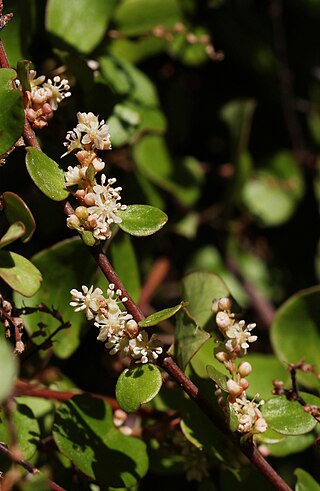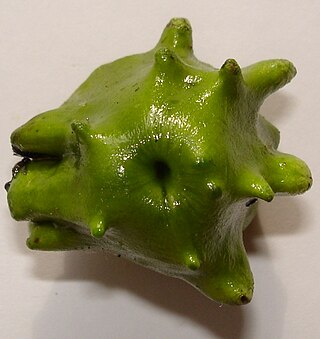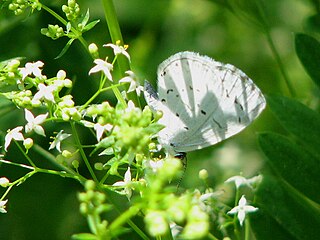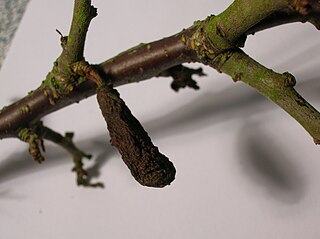
Galls or cecidia are a kind of swelling growth on the external tissues of plants, fungi, or animals. Plant galls are abnormal outgrowths of plant tissues, similar to benign tumors or warts in animals. They can be caused by various parasites, from viruses, fungi and bacteria, to other plants, insects and mites. Plant galls are often highly organized structures so that the cause of the gall can often be determined without the actual agent being identified. This applies particularly to some insect and mite plant galls. The study of plant galls is known as cecidology.

Prunus padus, known as bird cherry, hackberry, hagberry, or Mayday tree, is a flowering plant in the rose family. It is a species of cherry, a deciduous small tree or large shrub up to 16 metres (52 ft) tall. It is the type species of the subgenus Padus, which have flowers in racemes. It is native to northern Europe and northern and northeast Asia, and is grown as an ornamental in North America.

Eriophyidae is a family of more than 200 genera of mites, which live as plant parasites, commonly causing galls or other damage to the plant tissues and hence known as gall mites. About 3,600 species have been described, but this is probably less than 10% of the actual number existing in this poorly researched family. They are microscopic mites and are yellow to pinkish white to purplish in color. The mites are worm like, and have only two pairs of legs. Their primary method of population spread is by wind. They affect a wide range of plants, and several are major pest species causing substantial economic damage to crops. Some species, however, are used as biological agents to control weeds and invasive plant species.

Muehlenbeckia complexa, commonly known as pohuehue, although this name also applies to some other climbers such as Muehlenbeckia australis.
Cherry mottle leaf virus (CMLV) is a plant pathogenic virus causing leaf rot. It is closely related to the peach mosaic virus.
Tydeus eriophyes is a species of mite belonging to the family Tydeidae. This small oval, eyeless mite is around 300 μm in length with a soft body covered in striations. It can be distinguished from similar species by the bluntly pointed, rod-like dorsal setae. This species is associated with the gall mite Eriophyes vitis on grapevines in the vicinity of Grabouw, South Africa.

Dibotryon morbosum or Apiosporina morbosa is a plant pathogen, which is the causal agent of black knot. It affects members of the Prunus genus such as; cherry, plum, apricot, and chokecherry trees in North America. The disease produces rough, black growths that encircle and kill the infested parts, and provide habitat for insects.

Andricus quercuscalicis is a gall wasp species inducing knopper galls.

Andricus foecundatrix is a parthenogenetic gall wasp which lays a single egg within a leaf bud, using its ovipositor, to produce a gall known as an oak artichoke gall, oak hop gall, larch-cone gall or hop strobile The gall develops as a chemically induced distortion of leaf axillary or terminal buds on pedunculate oak or sessile oak trees. The larva lives inside a smaller hard casing inside the artichoke and this is released in autumn. The asexual wasp emerges in spring and lays her eggs in the oak catkins. These develop into small oval galls which produce the sexual generation of wasps. A yew artichoke gall caused by the fly Taxomyia taxi also exists, but is unrelated to the oak-borne species. Previous names or synonyms for the species A. fecundator are A. fecundatrix, A. pilosus, A. foecundatrix, A. gemmarum, A. gemmae, A. gemmaequercus, A. gemmaecinaraeformis and A. quercusgemmae.

Eriophyes tiliae is a mite that forms the lime nail gall or bugle gall. It develops in a chemically induced gall; an erect, oblique or curved distortion rising up from the upper surface of the leaves of the lime (linden) trees, such as the large-leaved lime tree Tilia platyphyllos, the common lime tree Tilia × europaea, etc.

Celastrina serotina, the cherry gall azure, is a butterfly of the family Lycaenidae. It is found across North America as far north as the treeline. Its flight time is between mid-May and mid-June in eastern Ontario after the spring azure and before the summer azure. The larva has been reported to feed on galls of eriophyid mites and apparently also on the mites themselves, making them one of the rare species of carnivorous Lepidoptera. It is commonly found around woodland roads of upland mixed deciduous hardwood forests which are surrounded by wetlands.

Taphrina pruni is a fungal plant pathogen of blackthorn that causes the pocket or bladder plum gall, a chemically induced distortion of the fruit (sloes), producing swollen on one side, otherwise deformed and flattened fruit gall without a stone. The twigs on infected plants may also be deformed with small strap-shaped leaves.

Eriophyes is a genus of acari that forms galls, specially on trees of the family Rosaceae. Some are called blister mites. The blue butterfly Celastrina serotina has been reported to feed on these galls and also on the mites, making it one of the uncommon carnivorous Lepidoptera.

Taphrina padi is a fungal plant pathogen that induces the form of pocket plum gall that occurs on bird cherry. The gall is a chemically induced distortion of the fruits, which are swollen, hollow, curved and greatly elongated, without a seed or stone, but retaining the style. The twigs on infected plants may also be deformed with small strap-shaped leaves.
Ascalenia antiqua is a moth in the family Cosmopterigidae. It is found in Israel and Egypt.

Phytoptus avellanae is an acarine gall-mite species inducing big bud galls of up to 10 millimetres (0.39 in) across, sometimes slightly open, on the buds of hazel and on filbert. Synonyms include Phytocoptella avellanae, Eriophyes avellanae, Calycophthora avellanae, Phytoptus coryli, Phytoptus pseudogallarum, and Acarus pseudogallarum. The mites are white, about 0.3 mm long, with numerous tergites and sternites. Two forms of P. avellanae exist, a gall causer and a vagrant form that has a more complex life-cycle and does not form galls.

Eriophyes inangulis is a mite that forms the alder vein angle gall. It develops in a chemically induced gall; a sub-spherical distortion rising up from the upper surface of the leaves of alder trees Alnus glutinosa along the midrib. Synonyms are Eriophyes laevis inangulis, Phytoptus laevis, and Cephaloneon pustulatum.

Phyllocoptes eupadi is a mite that chemically induces a pouch gall to develop as a sub-spherical distortion rising up from the upper surface of the lamina of leaves of blackthorn shrubs Prunus padus, Prunus spinosa and other Prunus species. Synonyms are Phytoptus padi Nalepa, 1890 and "Eriophyes padi ", non Eriophyes padi Domes, 2000.
Prunus cornuta, the Himalayan bird cherry, is a species of bird cherry native to the foothills of the Himalayas, including China and the countries of the Indian subcontinent. A medium-sized tree, it can reach 18 m. It is used for a rootstock for sweet cherries in India. Its specific epithet references the "horned" deformation of the fruit seen when a tree is afflicted with the fungal disease pocket plum gall, ascribed to the species Taphrina padi.

Eriophyes laevis is a gall mite which makes small, pimple-like galls on the leaves of alder. The mite was first described by the Austrian zoologist, Alfred Nalepa in 1889 and is found in Europe and North America.













